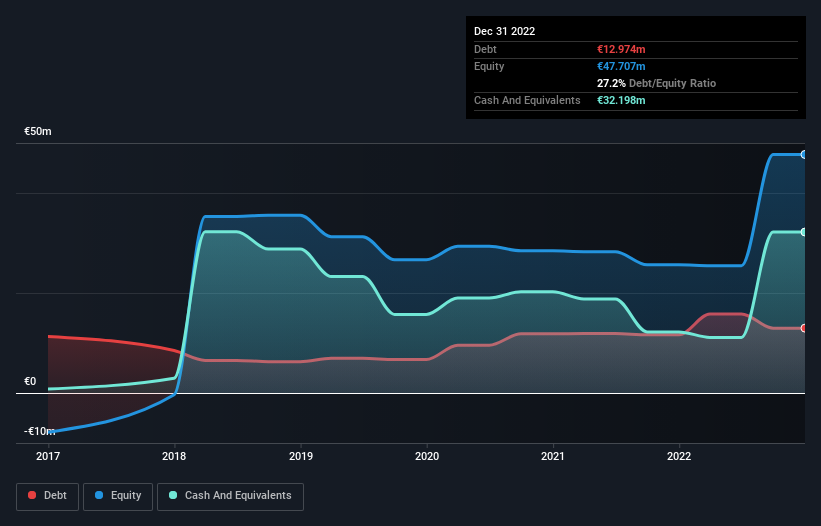Warren Buffett famously said, 'Volatility is far from synonymous with risk.' When we think about how risky a company is, we always like to look at its use of debt, since debt overload can lead to ruin. We can see that Kalray S.A. (EPA:ALKAL) does use debt in its business. But should shareholders be worried about its use of debt?
When Is Debt A Problem?
Generally speaking, debt only becomes a real problem when a company can't easily pay it off, either by raising capital or with its own cash flow. If things get really bad, the lenders can take control of the business. While that is not too common, we often do see indebted companies permanently diluting shareholders because lenders force them to raise capital at a distressed price. Of course, the upside of debt is that it often represents cheap capital, especially when it replaces dilution in a company with the ability to reinvest at high rates of return. When we think about a company's use of debt, we first look at cash and debt together.
See our latest analysis for Kalray
What Is Kalray's Net Debt?
The image below, which you can click on for greater detail, shows that at December 2022 Kalray had debt of €13.0m, up from €11.6m in one year. But on the other hand it also has €32.2m in cash, leading to a €19.2m net cash position.

A Look At Kalray's Liabilities
Zooming in on the latest balance sheet data, we can see that Kalray had liabilities of €6.29m due within 12 months and liabilities of €34.0m due beyond that. On the other hand, it had cash of €32.2m and €10.7m worth of receivables due within a year. So it actually has €2.57m more liquid assets than total liabilities.
Having regard to Kalray's size, it seems that its liquid assets are well balanced with its total liabilities. So it's very unlikely that the €233.7m company is short on cash, but still worth keeping an eye on the balance sheet. Simply put, the fact that Kalray has more cash than debt is arguably a good indication that it can manage its debt safely. The balance sheet is clearly the area to focus on when you are analysing debt. But it is future earnings, more than anything, that will determine Kalray's ability to maintain a healthy balance sheet going forward. So if you want to see what the professionals think, you might find this free report on analyst profit forecasts to be interesting.
Over 12 months, Kalray reported revenue of €31m, which is a gain of 151%, although it did not report any earnings before interest and tax. So its pretty obvious shareholders are hoping for more growth!
So How Risky Is Kalray?
We have no doubt that loss making companies are, in general, riskier than profitable ones. And in the last year Kalray had an earnings before interest and tax (EBIT) loss, truth be told. Indeed, in that time it burnt through €17m of cash and made a loss of €16m. But at least it has €19.2m on the balance sheet to spend on growth, near-term. The good news for shareholders is that Kalray has dazzling revenue growth, so there's a very good chance it can boost its free cash flow in the years to come. High growth pre-profit companies may well be risky, but they can also offer great rewards. There's no doubt that we learn most about debt from the balance sheet. However, not all investment risk resides within the balance sheet - far from it. For instance, we've identified 2 warning signs for Kalray that you should be aware of.
If you're interested in investing in businesses that can grow profits without the burden of debt, then check out this free list of growing businesses that have net cash on the balance sheet.
Valuation is complex, but we're here to simplify it.
Discover if Kalray might be undervalued or overvalued with our detailed analysis, featuring fair value estimates, potential risks, dividends, insider trades, and its financial condition.
Access Free AnalysisHave feedback on this article? Concerned about the content? Get in touch with us directly. Alternatively, email editorial-team (at) simplywallst.com.
This article by Simply Wall St is general in nature. We provide commentary based on historical data and analyst forecasts only using an unbiased methodology and our articles are not intended to be financial advice. It does not constitute a recommendation to buy or sell any stock, and does not take account of your objectives, or your financial situation. We aim to bring you long-term focused analysis driven by fundamental data. Note that our analysis may not factor in the latest price-sensitive company announcements or qualitative material. Simply Wall St has no position in any stocks mentioned.
About ENXTPA:ALKAL
Moderate risk and fair value.
Market Insights
Community Narratives



